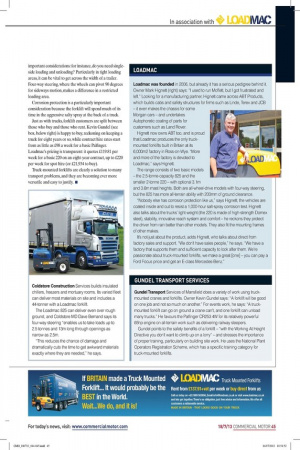ALL grown up There's plenty of choice in the truck-mounted
Page 36

Page 37

If you've noticed an error in this article please click here to report it so we can fix it.
forklift market now, and new technology is set to make them more useful than ever Words: Toby Clark Truck-mounted forklifts can be great additions to haulage fleets because they give extra flexibility: they allow trucks to deliver to retail locations without loading docks or their own forklifts, as well as undertaking the more traditional applications of moving building materials and the like. There's an obvious payload penalty in carrying a forklift — from 1,300kg to 2,500kg for the forklift itself, plus another 150kg to 300kg for its mounting gear — but increased utilisation can make it worthwhile. Not only is unloading easier, but it also increases the chances of taking on a backload.
For an own-account operator, the benefits can be even greater: a single forklift can be shared between several depots or stores, needing only one trained operator.
At one time the Moffett Mounty was to truck-mounted forklifts what Hoover was to vacuum cleaners, but the market has moved on. While Moffett — now part of the Finnish Cargotec group along with Hiab — is still the major name in the market, it is up against stiff competition from Pa'finger Crayler, Manitou and Loadmac.
Almost all truck-monted forklifts are diesel-powered, with hydraulic drive either to the rear steering wheel or to all three wheels.
Electric forklifts have long been common in warehouse applications, but until now battery technology has ruled them out of truck mounting: Hiab Moffett has developed an electric truck-mounted forklift (see box), however, and Loadmac will soon follow.
Important considerations Basic models have one-wheel drive, but all-wheel drive gives better traction for off-road applications, although at a penalty in weight and cost.
As with any forklift, reach and mast movement are important considerations: for instance, do you need singleside loading and unloading? Particularly in tight loading areas, it can be vital to get across the width of a trailer. Four-way steering, where the wheels can pivot 90 degrees for sideways motion, makes a difference in a restricted loading area.
Corrosion protection is a particularly important consideration because the forklift will spend much of its time in the aggressive salty spray at the back of a truck.
Just as with trucks, forklift customers are split between those who buy and those who rent. Kevin Gundel (see box, below right) is happy to buy, reckoning on keeping a truck for eight years or so, while contract hire rates start from as little as £98 a week for a basic Pa'finger. Loadmac's pricing is transparent: it quotes £119.81 per week for a basic 220 on an eight-year contract, up to £220 per week for spot hire (or £21,934 to buy).
Truck-mounted forklifts are clearly a solution to many transport problems, and they are becoming ever more versatile and easy to justify. •








































